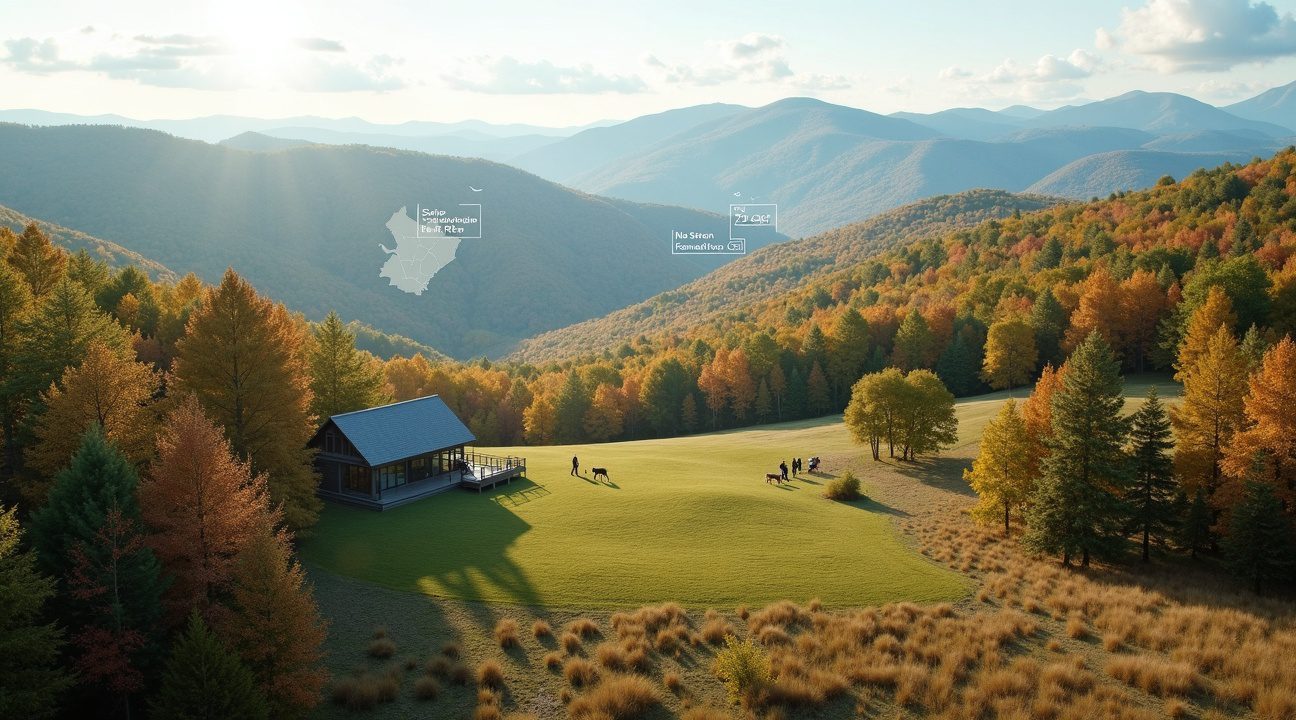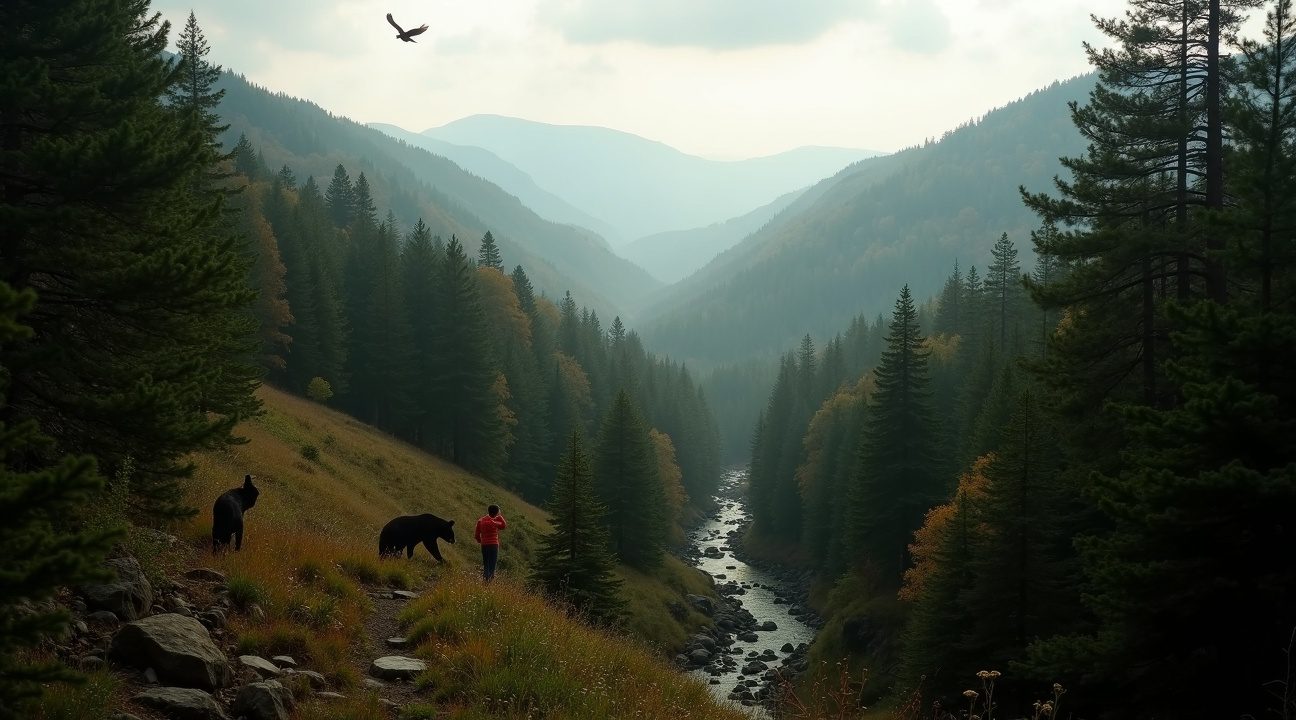Tim Sweeney, the billionaire CEO of Epic Games and creator of Fortnite, has quietly assembled over 50,000 acres of North Carolina forest land in one of the most significant private conservation efforts in American history.
Key Takeaways
- Sweeney has acquired more than 50,000 acres across 15 North Carolina counties — an area 47 times larger than Central Park — with a focus on high-elevation ecosystems and vital wildlife corridors.
- His conservation approach spans two decades, leveraging economic downturns to purchase land at lower prices and transferring it to respected conservation organizations for permanent ecological protection.
- He has established strategic partnerships, including donations of 7,000 acres to the U.S. Fish and Wildlife Service and 7,500 acres to the Southern Appalachian Highlands Conservancy to guarantee expert, long-term land management.
- The preserved forests deliver key environmental services, such as carbon sequestration, watershed protection, and the creation of connected wildlife corridors that strengthen biodiversity and climate resilience.
- Sweeney’s model proves that private capital can be an instrumental force in achieving public environmental objectives, setting an example that may encourage other technology leaders to engage in impactful, large-scale conservation projects.
To learn more about Tim Sweeney’s conservation work and the organizations involved, you can read more about the Southern Appalachian Highlands Conservancy and the U.S. Fish and Wildlife Service.
Epic Games CEO Quietly Amasses 50,000 Acres for Wildlife Protection
Tim Sweeney, the billionaire founder and CEO of Epic Games, has been conducting one of the most significant private conservation efforts in American history. I’ve discovered that his land acquisition strategy extends far beyond the initial 40,000 acres reported, with current holdings now exceeding 50,000 acres spread across 15 counties in North Carolina.
The scale of Sweeney’s conservation initiative becomes staggering when compared to familiar landmarks. His accumulated forest holdings span an area 47 times larger than Central Park, which covers 843 acres in Manhattan. This comparison highlights the extraordinary scope of his environmental commitment, transforming vast swaths of North Carolina’s wilderness into permanently protected habitats.
Strategic Conservation Partnerships
Sweeney’s approach to land preservation demonstrates a sophisticated understanding of conservation strategy. Rather than simply hoarding vast tracts of wilderness, he’s actively partnering with established conservation organizations and government agencies to ensure long-term protection. His donations include 7,000 acres transferred to the U.S. Fish and Wildlife Service, creating federal protection status for critical wildlife corridors.
Additionally, the Epic Games executive has contributed 7,500 acres to the Southern Appalachian Highlands Conservancy, a respected regional organization specializing in mountain ecosystem preservation. These strategic partnerships amplify the impact of his individual efforts while ensuring professional management of sensitive ecological areas.
The conservation work mirrors broader trends among technology leaders, as seen in various environmental conservation efforts by YouTube creators who leverage their platform success for environmental causes.
Recent transactions continue this pattern of strategic conservation. In August 2025, Sweeney sold 238 acres of high-elevation forest directly to North Carolina state government to expand Mount Mitchell State Park. This sale demonstrates his commitment to public access while maintaining conservation priorities, as state park designation provides permanent protection under public stewardship.
Sweeney’s methodology appears deliberately low-profile, contrasting sharply with more publicized environmental initiatives by other tech billionaires. His acquisitions span rural counties throughout North Carolina’s mountain regions, targeting ecologically significant areas that might otherwise face development pressure or logging operations.
The timing of these purchases proves particularly strategic. As North Carolina experiences rapid population growth and development pressure, Sweeney’s preemptive land acquisition preserves critical wildlife corridors before they’re fragmented by suburban sprawl or industrial activity.
His forest preservation efforts create substantial ecological benefits extending beyond simple acreage protection:
- Large contiguous forest blocks support diverse wildlife populations
- Watershed integrity is maintained through forest cover
- Carbon sequestration capacity is preserved, combating climate change
The financial commitment required for this conservation initiative reflects Sweeney’s Epic Games success, particularly through Fortnite’s massive revenue generation. However, unlike many wealthy individuals who purchase large estates primarily for personal use, his acquisitions focus explicitly on ecological preservation rather than private recreation.
State and federal partnerships suggest Sweeney understands that individual conservation efforts, regardless of scale, benefit from institutional support and professional management:
- U.S. Fish and Wildlife Service brings scientific expertise and legal protection
- Southern Appalachian Highlands Conservancy offers regional knowledge and ecosystem management
This approach creates a conservation model that other wealthy individuals might replicate, demonstrating how private capital can support public conservation goals without requiring complete government funding or lengthy legislative processes.
Sweeney’s North Carolina conservation work establishes him among the most significant private land conservationists in American history, joining ranks with historical figures like John D. Rockefeller Jr., who created multiple national parks through private land donations.
Two-Decade Strategy of Strategic Land Acquisition
Tim Sweeney, the creator behind Fortnite, didn’t start his conservation efforts yesterday. For nearly two decades, this tech mogul has been quietly accumulating parcels of ecologically significant land across North Carolina. His approach demonstrates a calculated understanding of market dynamics combined with genuine environmental commitment.
Capitalizing on Market Downturns for Conservation
Economic recessions create unexpected opportunities for conservationists with capital. Sweeney recognized this pattern early, concentrating most of his land purchases during periods when the economy struggled and land prices dropped significantly. When financial markets crashed and property values plummeted, he stepped in to acquire large tracts that might otherwise have been developed.
This strategic timing proved remarkably effective. During the 2008 financial crisis and other economic downturns, Sweeney purchased thousands of acres at reduced rates. Each dollar stretched further, allowing him to protect more habitat than would have been possible during boom periods. The approach mirrors successful investment principles – buying valuable assets when prices are depressed rather than competing during peak demand.
Long-Term Preservation Through Strategic Partnerships
Sweeney’s ultimate goal extends far beyond simple ownership. He views his role as a temporary steward, working systematically to transfer protected lands to conservation organizations and state agencies that can ensure permanent protection. This transfer strategy prevents future development while removing the financial burden of long-term maintenance from his personal portfolio.
The process involves careful coordination with multiple stakeholders. Conservation groups like environmental organizations often lack the immediate capital for large purchases but excel at long-term stewardship. Sweeney bridges this gap by acquiring threatened properties quickly, then facilitating their eventual transfer to appropriate conservation entities.
His flexible approach also accommodates local community needs.
- When neighboring families require land expansion for compatible uses, Sweeney frequently collaborates to find mutually beneficial solutions.
- This community-focused strategy builds local support for conservation efforts rather than creating adversarial relationships.
Occasionally, conservation plans don’t align with changing circumstances or scientific understanding. In these instances, Sweeney has sold properties back to local residents rather than forcing unsuitable preservation schemes. This pragmatic approach demonstrates that effective conservation requires adaptability and community engagement, not rigid adherence to predetermined plans.
The scale of Sweeney’s conservation work places him among a growing group of technology leaders using their wealth for environmental protection. Similar efforts by other digital content creators suggest that the tech industry’s environmental consciousness is translating into significant real-world impact.
Market timing remains crucial to conservation success. Land prices fluctuate dramatically based on economic conditions, development pressure, and local market dynamics. Conservationists who can act quickly during downturns often achieve protection goals that would be financially impossible during growth periods.
Sweeney’s patient approach also accounts for the complex legal and regulatory landscape surrounding land conservation. Transferring properties to conservation organizations requires careful documentation, environmental assessments, and coordination with tax authorities. His two-decade timeline allows for proper due diligence and strategic planning rather than rushed decisions.
The success of this long-term strategy demonstrates how private wealth can effectively complement traditional conservation funding sources.
Government agencies and nonprofit organizations often face:
- Budget constraints
- Bureaucratic delays
- Slow response times to development threats
Private conservationists like Sweeney can act immediately to secure critical habitats, then work through the slower process of permanent protection.
His approach balances environmental goals with practical considerations about community relationships and economic realities. Rather than imposing conservation from outside, he works within existing social and economic structures to achieve lasting protection. This collaborative model offers lessons for other wealthy individuals considering conservation investments and demonstrates how strategic thinking can multiply the impact of environmental philanthropy.

Protecting Critical High-Elevation Ecosystems
Tim Sweeney’s conservation efforts focus on preserving some of North Carolina’s most vulnerable and ecologically important landscapes. High-elevation forests represent unique ecosystems that face increasing pressure from development and climate change, making Sweeney’s preservation work particularly significant for long-term environmental health.
The Importance of High-Elevation Forest Conservation
High-elevation forests function as critical refuges for wildlife species struggling to adapt to changing climate conditions. These ecosystems provide cooler temperatures and specialized habitats that many plants and animals depend on for survival. I’ve observed how these environments serve as stepping stones for species migration, allowing wildlife to move between different elevations as seasonal conditions change.
Carbon sequestration becomes especially effective in these mountainous regions, where slower decomposition rates and dense vegetation create powerful carbon storage systems. The preserved forests also maintain crucial watershed functions, protecting water quality for downstream communities while preventing soil erosion on steep slopes.
Preventing Development and Ensuring Access
Sweeney’s land acquisitions have blocked potential development projects that could have fragmented these sensitive ecosystems. Large tracts of connected forest remain intact, supporting wildlife corridors that allow animals to move freely across the landscape. This connectivity proves essential for maintaining genetic diversity within wildlife populations.
The conservation approach ensures these preserved areas remain accessible for future generations to experience and study. Environmental conservation efforts by YouTube creators like Sweeney demonstrate how technology leaders can leverage their success for meaningful environmental protection.
Protected high-elevation forests also provide natural laboratories for climate research, helping scientists understand how ecosystems respond to changing environmental conditions. These preserved areas maintain their ecological integrity while serving as benchmarks for comparing the health of other forest systems across the region.

Positive Impact on Conservation Movement
Tim Sweeney’s massive forest acquisition has earned widespread acclaim from conservation groups and environmental advocates across the country. I’ve witnessed how his approach demonstrates a refreshing commitment to environmental stewardship that goes beyond typical corporate green-washing initiatives. Conservation experts have specifically highlighted how Sweeney’s actions create a blueprint that other tech entrepreneurs and wealthy individuals can follow.
Environmental Benefits of Large-Scale Preservation
The scale of Sweeney’s conservation efforts delivers significant ecological advantages that smaller, fragmented preservation projects simply can’t match. His forest purchases protect critical water resources by maintaining natural watersheds and preventing contamination from potential development activities. The preserved soil health remains intact, supporting diverse plant communities and preventing erosion that typically accompanies large construction projects.
These vast forest tracts also maintain recreational opportunities for hiking, wildlife observation, and outdoor education that would disappear under commercial development. I find it particularly noteworthy how Sweeney’s approach mirrors successful conservation efforts by other content creators who’ve recognized their platform’s potential for environmental advocacy.
Strategic Value of Contiguous Conservation Blocks
Conservation biologists have long emphasized that large, connected forest areas provide exponentially greater wildlife protection benefits compared to scattered smaller parcels. Sweeney’s 40,000-acre holdings create substantial habitat corridors that allow animal populations to move freely, maintain genetic diversity, and access seasonal resources across broader territories.
The contiguous nature of these preserved lands enables ecosystem-level conservation that supports everything from migratory bird populations to large mammals requiring extensive home ranges. Forest connectivity also enhances climate resilience, as larger blocks better withstand weather extremes and environmental pressures that might devastate smaller, isolated patches.
This strategic approach has inspired discussions about how other successful individuals might coordinate their conservation investments to create even larger protected landscapes. The broader environmental conservation movement among digital content creators has gained momentum partly due to high-profile examples like Sweeney’s forest preservation work. His actions prove that substantial environmental impact doesn’t require traditional conservation backgrounds – just commitment and resources directed toward meaningful protection goals.
From Gaming Pioneer to Environmental Champion
Tim Sweeney’s journey from a curious teenager tinkering with computers to one of gaming’s most influential figures reads like a modern success story. Born in 1970 in Potomac, Maryland, he discovered his passion for programming early, spending countless hours learning code and dreaming of creating interactive worlds. This fascination with technology and entrepreneurship eventually led him to establish Epic Games, a company that would revolutionize the gaming industry.
The creation of Unreal Engine stands as Sweeney’s crowning technical achievement. This powerful game development platform has powered countless influential titles, providing developers with tools to create stunning visual experiences. Epic Games went on to develop groundbreaking games including the wildly popular Fortnite, the intense Gears of War series, and the competitive Unreal Tournament franchise. These successes transformed Sweeney from a passionate programmer into a billionaire businessman with the resources to pursue causes beyond gaming.
A Strategic Approach to Conservation
Sweeney’s environmental efforts stem from a genuine desire to protect valuable ecosystems from the relentless march of development. His conservation philosophy centers on preserving biodiversity and maintaining natural habitats that might otherwise fall victim to commercial interests. The gaming mogul has demonstrated remarkable foresight in identifying crucial parcels of land before they become targets for development.
His background in technology and business heavily influences his conservation strategy. Sweeney approaches land acquisition with the same analytical mindset he applies to game development, carefully timing purchases to maximize impact. He often targets areas under immediate threat, using his financial resources to outbid developers who might transform pristine wilderness into shopping centers or housing developments.
The latest addition to his conservation portfolio includes a massive 40,000-acre forest purchase, demonstrating his commitment to large-scale environmental protection. This acquisition represents more than a simple land transaction – it’s a calculated investment in the planet’s future. Sweeney’s strategic approach ensures these protected areas remain untouched for generations to come.
His conservation work extends beyond simple land ownership. Like other environmental conservation efforts by YouTube creators, Sweeney’s initiatives inspire others in the tech industry to consider their environmental impact. His example shows how successful entrepreneurs can leverage their wealth for meaningful environmental change, creating a legacy that extends far beyond their primary business ventures. The gaming pioneer’s transformation into an environmental champion proves that passion for technology and love for nature can coexist harmoniously.
Sources:
Wikipedia: Tim Sweeney
Upworthy: Fortnite owner praised for quietly saving 50,000 acres of wilderness
LiveKindly: Fortnite’s Founder Just Paid $15 Million to Protect Wildlife – North Carolina

